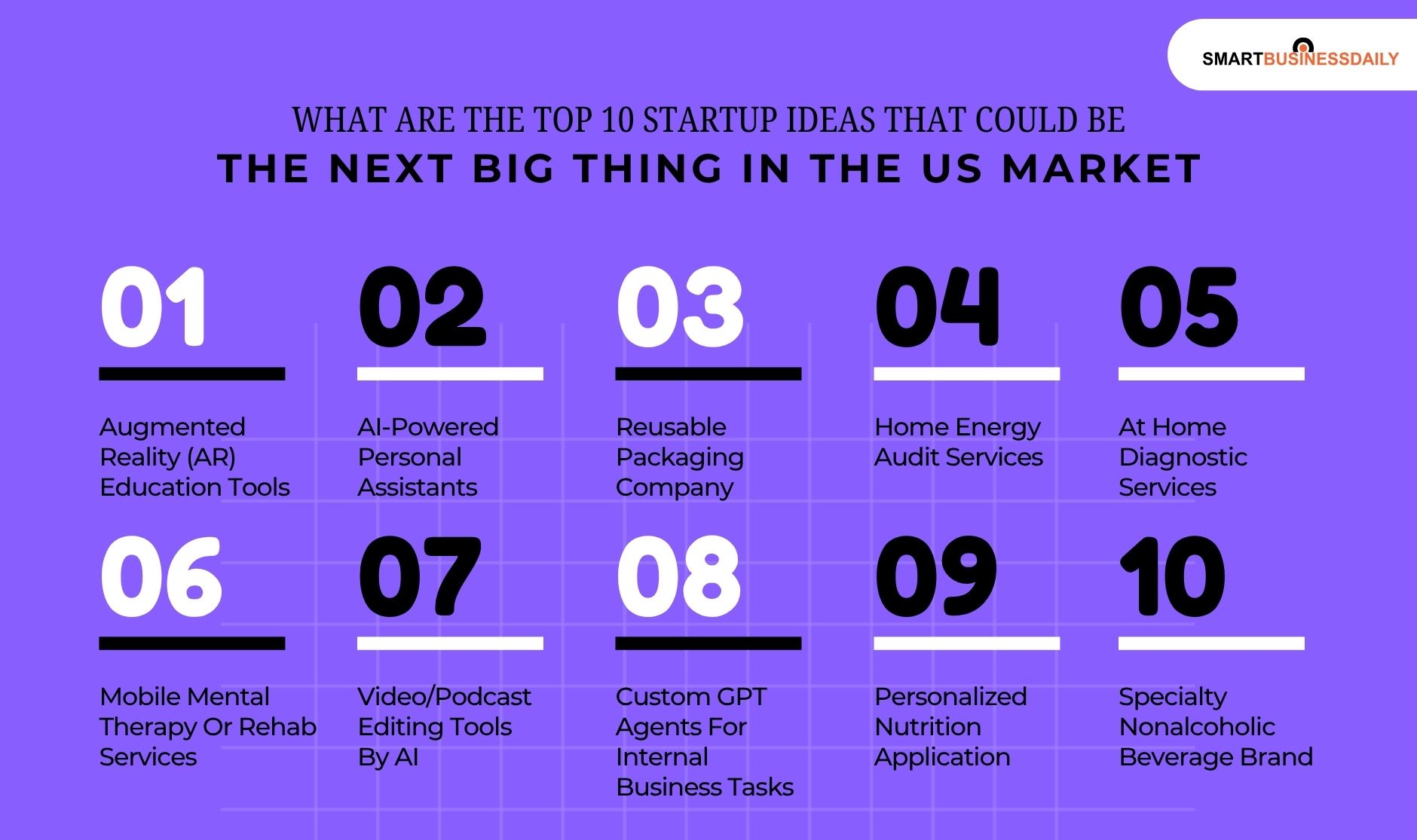The Top 10 Startup Ideas In USA Explained For 2026 And Beyond (+Useful Tips)
18 October 2025
12 Mins Read

- How Does The US Market Look Like In 2025?
- What Are The Top 10 Startup Ideas That Could Be The Next Big Thing In The US Market?
- 1. Augmented Reality (AR) Education Tools
- Target Audience
- Possible Revenue Streams
- Possible Challenges And Risks
- 2. AI-Powered Personal Assistants
- Target Audience
- Possible Revenue Streams
- Possible Challenges And Risks
- 3. Reusable Packaging Company
- Target Audience
- Possible Revenue Streams
- Possible Risks And Challenges
- 4. Home Energy Audit Services
- Target Audience
- Possible Revenue Streams
- Possible Risks And Challenges
- 5. At Home Diagnostic Services
- Target Audience
- Possible Revenue Streams
- Possible Risks And Challenges
- 6. Mobile Mental Therapy Or Rehab Services
- Target Audience
- Possible Revenue Streams
- Possible Risks And Challenges
- 7. Video/Podcast Editing Tools By AI
- Target Audience
- Possible Revenue Streams
- Possible Risks And Challenges
- 8. Custom GPT Agents For Internal Business Tasks
- Target Audience
- Possible Revenue Streams
- Possible Risks And Challenges
- 9. Personalized Nutrition Application
- Target Audience
- Possible Revenue Streams
- Possible Risks And Challenges
- 10. Specialty Nonalcoholic Beverage Brand
- Target Audience
- Possible Revenue Streams
- Possible Risks And Challenges
- What Are The Legal Steps To Navigate For A Startup?
- 1. Register Your Business
- 2. Apply For Licenses And Permits
- 3. Ensure Regulatory Compliance
- 4. Draft Essential Agreements
- 5. Protect Your IP
- 6. Register Your IP
Are you an aspiring entrepreneur? Well, I was one at some time too!
Trust me, you are just one brilliant business idea away from taking that leap into becoming your own boss.
However, I think coming up with that perfect idea is often more challenging than it sounds.
The most successful startup ideas usually revolve around solving a problem.
Additionally, you can address an unmet need or enhance something already available in the market. Ideally, they do a bit of all three.
Need some help? I got you! I am giving you 10 ideas to spark your creativity.
Use these as you work towards launching your own business.
How Does The US Market Look Like In 2025?
Over the last ten years, the landscape of entrepreneurship in the U.S. has seen significant growth.
The number of new business applications has more than doubled from 2.8 million to over 5.5 million each year.
This remarkable increase showcases a thriving entrepreneurial culture. Additionally, it also shows a growing passion among individuals to start their own ventures.
The rise in applications is not just a statistic. It highlights the exciting opportunities that many people are pursuing in their quest for innovation and success.
What Are The Top 10 Startup Ideas That Could Be The Next Big Thing In The US Market?

These are the top 10 startup ideas that have the highest probability of success in 2026 and beyond. Let’s take a look!
1. Augmented Reality (AR) Education Tools
The education sector is ready for change, and AR education tools are leading this shift. These tools add digital information to the real world.
Additionally, these make learning more engaging and memorable. AR can bring historical events to life.
Also, they can help visualise complex scientific ideas and provide hands-on training for technical skills.
AR education tools have endless possibilities for enhancing learning.
Target Audience
K-12 and higher education students, particularly those in STEM fields. Additionally, there are students with learning disabilities. Also, adult learners in professional training programs.
Possible Revenue Streams
A startup for Augmented Reality (AR) educational tools can generate revenue through several models, including:
- Selling individual AR content packs
- Offering tiered subscriptions for content access
- Licensing the technology to schools or educational publishers
- Creating customized AR solutions for institutions
Possible Challenges And Risks
These are the possible challenges and risks you have to mitigate in this startup:
- The initial investment for developing high-quality AR content, hardware (like compatible devices), and software can be high.
- AR is still an evolving technology and can be plagued by technical issues such as software bugs.
- Creating high-quality, curriculum-aligned AR content requires specialized skills and resources. This leads to a current scarcity of available educational materials.
- Educators may lack the training to effectively integrate AR into their lessons, creating a barrier to adoption and use.
2. AI-Powered Personal Assistants
Personal assistants powered by artificial intelligence (AI) are changing how we handle our daily lives and work.
These smart digital helpers use machine learning and natural language processing. They need to understand what users need and offer personalized support.
They do much more than just schedule appointments and send reminders. AI assistants help manage complex projects.
Additionally, they provide insights for better decision-making.
So, you can claim that they are becoming essential tools for both professionals and individuals.
With the global AI market expected to reach $200 billion by 2025, there is great potential for startups in this field to grow and innovate.
Target Audience
Millennials, Productivity Seekers, Gen Z, Consumers focused on Lifestyle and Health.
Possible Revenue Streams
These are a few ways you can generate revenue from this startup:
- Premium Subscriptions
- In-app Purchases
- Affiliate Links
- Transactional Fees
Possible Challenges And Risks
These are the possible challenges and risks you will face in this startup:
- AI assistants collect sensitive personal data, which is a prime target for cybercriminals.
- The assistant may misinterpret user commands, leading to errors, frustration, and inefficiency.
- AI can perpetuate and amplify biases present in the training data, leading to discriminatory outcomes.
- Users may be reluctant to adopt the technology due to a lack of understanding, a fear of job displacement, or general resistance to new tools.
3. Reusable Packaging Company
The fight against single-use packaging is getting stronger, and businesses are looking for eco-friendly options for shipping and logistics.
The global market for reusable packaging could exceed $190 billion by 2030, according to a report from Grand View Research, Inc. Small.
Mid-sized businesses need flexible solutions to meet regulations, reduce waste, and improve their sustainability image with customers.
Entrepreneurs can create solutions like smart packaging with simple designs and clear recycling instructions for those ready to take on this challenge.
Target Audience
Food & Beverage Companies, Online Food Delivery Businesses, Environmentally Conscious Consumers
Possible Revenue Streams
These are the possible ways you can generate revenue in this startup:
- Packaging-as-a-service (PaaS)
- Reverse Logistics Fees
- Direct Sales
Possible Risks And Challenges
These are the possible risks and challenges you might face in this startup:
- Establishing a reusable packaging system requires substantial upfront capital.
- Additionally, this is different than single-use packaging. Reusable systems have ongoing operational costs for reverse logistics.
Also, you ned to pay extra for cleaning, tracking, and maintenance.
- A reusable model introduces reverse logistics. It is the process of collecting and returning used packaging. So, this is a complex operation.
- Many consumers find reusable packaging inconvenient.
Yes, they require extra effort to remember their containers. Additionally, they will need to clean them and return them to a collection point.
4. Home Energy Audit Services
Homeowners can receive up to $3,200 in tax credits for energy-efficient upgrades through the Inflation Reduction Act.
This opportunity is available for home improvements made until 2032. However, many homeowners are unsure how to use these tax incentives.
Some HVAC companies are starting to offer home energy audits. But more companies need to create similar services.
Additionally, they need to provide retrofitting options.
Also, this will help people make their homes more energy-efficient.
Target Audience
Cost-conscious homeowners, environmentally conscious consumers, and old home residents
Possible Revenue Streams
These are the possible ways you can generate revenue in this startup:
- Maintenance Contracts
- Referral and Commission
- Product Sales
- Specialized Audits
Possible Risks And Challenges
These are the top risks and challenges you will face in this startup:
- Homeowners can perform their own “do-it-yourself” energy audits. You just need to use online checklists and basic resources.
Additionally, this means your startup must provide significantly greater value to justify its cost.
- The online marketplace is crowded with energy-related content and services.
So, your startup will need to establish its brand and stand out against larger, more established companies with greater brand loyalty.
- A startup must secure sufficient funding for high-tech equipment, certifications, and marketing to get off the ground.
5. At Home Diagnostic Services
As health care costs and access become more uncertain, many people are looking for ways to track their health at home that protect their privacy.
Since the COVID-19 pandemic, more individuals have sought convenient at-home testing options, preferring these to visits to traditional health care facilities.
Additionally, the market for these home diagnostic tools is expected to grow at a rate of 8.2% annually. Also, it will reach over $22 billion by 2030.
Home testing services let users take samples at home. These services range from hormone panels to food sensitivity kits,
Then, they send them to independent labs. This gives you quick results without needing to see a doctor.
Entrepreneurs can work with certified labs to target specific areas like
- Fertility
- Chronic illnesses
- Wellness tracking
Target Audience
Individuals with chronic illnesses, the elderly and immobile, busy professionals, and a growing segment of health-conscious consumers.
Possible Revenue Streams
These are the ways you can generate revenue in this startup:
- Pay-per service
- Health check-up practices
- Subscription plans
- Diagnostic marketing commissions
Possible Risks And Challenges
These are the risks and challenges you will face in this startup:
- Ensuring accurate and reliable results is a core challenge. Samples must be collected, handled, and transported under strict, often temperature-controlled, conditions to preserve their integrity.
- Improper technique by patients or poorly trained phlebotomists can result in contaminated or insufficient samples, compromising reliability.
- A startup must manage a range of legal regulations for licensing and accreditation, and these guidelines constantly evolve with technological advancements.
- Handling and sharing confidential patient data requires strict adherence to privacy regulations like HIPAA or GDPR.
6. Mobile Mental Therapy Or Rehab Services
Telemedicine and remote therapy programs have made it easier to provide medical care at home.
The high costs of healthcare and an older population have increased the demand for mobile physical therapy services.
The global market for outpatient home therapy is expected to grow by 7.3% each year from 2025 to 2031.
Companies that offer personalised and convenient rehabilitation options give people flexible ways to get post-acute care from their own homes.
Target Audience
Individuals in Rehabilitation, Support Network, Tech-centric user segments
Possible Revenue Streams
A mobile mental therapy startup for rehab services can generate revenue through a combination of direct payments from users and contracts with larger organisations.
Other sorts of revenue generation include:
- Subscription fees
- In-app purchases
- Affiliate marketing
- Corporate wellness programs
- Contracts with rehabilitation centres
- Value-based care agreements
Possible Risks And Challenges
These are the risks and challenges you might face in this startup:
- The mental health app market lacks uniform regulation. This makes it difficult for users and professionals to judge an app’s credibility.
- A major data breach can have devastating consequences for thousands of users. This is exemplified by the Vastaamo psychotherapy hack in Finland.
- An app with a poor user interface or frustrating navigation will lead to low engagement and decreased user satisfaction.
7. Video/Podcast Editing Tools By AI
The creator economy is set to reach $480 billion by 2027. Content creators will need help to keep up with demand and competition.
Additionally, AI-powered editing tools like Descript and Adobe Podcast can streamline the workflow by offering features like:
- Audio and video editing
- Enhancement
- Transcription
A new service that combines smart automation with creative editing can help creators produce short-form clips and meet the rising demands by 2025.
These AI-enhanced tools can support creators in this growing market while allowing them to focus on what they love most: creating content.
Target Audience
Content creators, marketing professionals, and media organizations.
Possible Revenue Streams
A startup that sells AI tools for editing videos and podcasts can make money in different ways.
- One option is to offer a tiered subscription service, where users pay for different levels of access.
- Another option is a freemium model, where basic features are free, and users can pay for extra features. They could also charge based on usage.
- Additional ways to earn revenue include one-time purchases for premium features or templates. They can sell add-on services, like customising AI-generated voices or providing advanced analytics.
- Another option is to license their core AI technology to other businesses.
Possible Risks And Challenges
These are the risks and challenges you might face in this startup:
- Biased, incomplete, or flawed data can lead to skewed, inaccurate, or subpar results, directly impacting the tool’s effectiveness.
- There is a strong threat of market consolidation.
- Your tools will handle vast amounts of user-uploaded video and audio data. You must implement robust privacy and security measures to prevent data breaches, protect personal information, and build user trust.
8. Custom GPT Agents For Internal Business Tasks
Many businesses want to work more efficiently and cut out unnecessary steps.
AI agents can help by automating tasks like generating reports, summarizing documents, and taking meeting notes quickly.
This can greatly increase overall productivity. As a result, there will be a higher demand for consultants who can build, teach, and deploy AI agents to meet the specific needs of companies.
Target Audience
Small and medium-sized businesses (SMBs), as well as specific functional departments within larger enterprises.
Possible Revenue Streams
A startup that offers Custom GPT agents for internal business tasks can make money in several ways, such as through:
- Subscriptions
- Pay-per-use
- Service-based options
Additionally, the best strategy typically combines regular software fees with custom development and consulting services.
Possible Risks And Challenges
These are the possible risks and challenges you will face in this startup:
- An agent’s performance can degrade over time as business processes and data evolve, a phenomenon known as “concept drift”. This requires a continuous process of monitoring, retraining, and fine-tuning, which is resource-intensive.
- A startup handling client data must navigate a complex landscape of data privacy laws like GDPR and HIPAA.
Failure to implement stringent security measures and adhere to compliance regulations can result in severe legal and financial penalties.
- For an internal agent to be effective, employees must trust its output. Risks like “hallucinations”—where the model generates plausible but inaccurate or nonexistent information—can erode user trust and slow adoption.
9. Personalized Nutrition Application
The combination of nutrition science, artificial intelligence (AI), and mobile technology has led to new personalized nutrition and meal-planning apps.
These apps use data from various sources, including:
- Wearables
- Genetic tests
- User preferences
They use this data to create customized diet suggestions and meal plans. Startups are building AI tools that can consider factors like a person’s gut bacteria and metabolic rate.
The personalized nutrition market is expected to grow to $23.3 billion by 2027, showing a strong demand for tailor-made health solutions.
Target Audience
Millennials and Gen Z, Busy professionals, Individuals with chronic conditions
Possible Revenue Streams
Here are some ways a personalized nutrition app startup can make money:
- You can offer subscription plans that charge users monthly or yearly.
- Additionally, you can sell premium features like meal plans and one-on-one consultations through in-app purchases.
- You can partner with food brands or nutritionists to create business opportunities.
- Also, you can use affiliate marketing to promote products and earn commissions.
- You can provide a freemium model where users can access basic features for free.
- Plus, you can sell anonymized user data with their consent.
Possible Risks And Challenges
These are the risks and challenges that you might face in this startup:
- Gathering the comprehensive data needed for true personalization—including genetics, gut microbiome, metabolomics, and behavioral information—is complex and expensive.
- Companies must be very careful not to make unsubstantiated medical claims that their app can diagnose, cure, or prevent a specific disease.
- Startups must prioritize robust security and transparent privacy policies to protect against data breaches.
Otherwise, it can compromise user trust and violate laws like GDPR and HIPAA.
10. Specialty Nonalcoholic Beverage Brand
The “sober-curious” movement is changing how people think about health and socializing.
There is a growing demand for tasty, alcohol-free drinks, such as botanical spirits and adaptogenic sodas.
Additionally, the U.S. nonalcoholic beverage market is expected to reach over $246 billion by 2032.
So, if you have Brands that provide flavorful, functional drinks without alcohol, they will attract health-minded Gen Zers.
Also, they will attract adults who want to cut back on drinking.
Target Audience
Health-conscious consumers, Millennials, Gen Z, Occasional Drinkers
Possible Revenue Streams
These are the ways you can generate revenue in this startup:
- Online store
- Subscription boxes
- Retailers
- Corporate and event sales
Possible Risks And Challenges
These are the possible risks and challenges that you might face in this startup:
- The nonalcoholic beverage market is crowded with large, established global players like PepsiCo and Coca-Cola, as well as numerous startups.
- Additionally, you will face volatility in the prices of raw materials and packaging.
Additionally, you will face the same issues in labor and transportation. It can put significant pressure on profit margins.
- Moreover, the rules governing nonalcoholic beverages, especially around labeling and health claims, can vary widely by region or even by state.
What Are The Legal Steps To Navigate For A Startup?
These are the few steps you should take to ensure your startup doesn’t face any legal hiccups:
1. Register Your Business
Register with the relevant authorities. These may include the Ministry of Corporate Affairs (MCA), which is for incorporation.
2. Apply For Licenses And Permits
You need to obtain industry-specific licenses, such as GST registration (if your turnover exceeds the threshold)
Additionally, you can go for an FSSAI license for food-related businesses.
3. Ensure Regulatory Compliance
You need to comply with all relevant laws, which can include labor laws. Additionally, it can include data protection regulations and industry-specific rules.
4. Draft Essential Agreements
Prepare documents like founder agreements, non-disclosure agreements (NDAs), and employment contracts to clarify roles, responsibilities, and protect your business.
5. Protect Your IP
Secure your intellectual property through trademarks, copyrights, and patents.
6. Register Your IP
Formally register your trademarks and other IP with the appropriate government bodies.



















Comments Are Closed For This Article